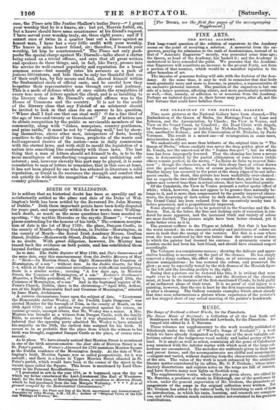THE CREAN IN GS IN T HE NATIONAL GALLERY.
Nine more pictures at the National Gallery have been deaned,—The Emberkation of the Queen of Sheba, the Marriage-Feast of Isaac and Rebecca, and the Annunciation, by Claude; the View in Venice and View on the Grand Canal, by Canaletti ; the Dead Christ with Angela, br Guercino ; the Plague at Ashdod, by Nicholas Poussin. ; the St. Ba- ron, ascribed to Rubens ; and the Consecration of St. Nicholas, by Paolo Veronese. The result is a mixed one—of reintegration in some cases, deterioration in others.
We undoubtedly see more than hitherto of the original tints in "The Queen of Sheba," whose sunlight was never the deep golden glow of the St. Ursula, nor the sunset-red of the "Italian Sea-port "- but its whole tone has been improperly lowered. That the cleaning has been a severe one, is demonstrated by the partial obliteration of some letters (while others remain perfect) in the motto, "La Heine de Saba va trouver Salo-
mon " though the characters, as being thin .sharp lines of colour drawn over the general surface, were of course peculiarly liable to erasure.
Similar injury has occurred to the paint at the sharp edges of its not infre- quent cracks. In short, this picture has been unskilfully over-cleaned: but as regards the two other Claudes, we consider that, not less in atmo- sphere Auld natural' tone than in actual colour, they have benefited greatly.
Of the Canalettis, the View in Venice presents a rather spotty effect of white; which, however, does not appear to be greater than naturally be- longs to it, and is more than compensated by the greatly improved chiaro- scuro, the deepening of dark colour by dark shadow, in the background: the Grand Canal has been reduced from the excessively murky tone it before presented, and is proportionately improved.
Some slurring of outline is to be perceived in the Guercino and the St. Baron. But, in the latter, the-free and dashing style of execution is ren-
dered 'far -more apparent., and the increased truth and variety of colour are most decided. The picture might have been better cleaned, yet it looks better even as it is.
The greatest sufferer is the Plague at Ashdod. Not that it has been the worst treated ; its own excessive crudity and patchiness of colour are more in fault than the energy of the restorer. But this is a case where even the tone conferred by dirt was better than the entire want of tone to which the painter had doomed his canvass. A systematic course of London smoke had been his best friend, and should have obtained respect accordingly. The Veronese is a conspicuous success ; showing the delicate and appre- ciative handling so necessary on the part of the cleaner. He has simply removed a dingy surface, the effect of time, or of extraneous and inju- dicious manipulations: he has restored the colour, anti -preserved the glow; as may be especially tested by the rich dresses of the Moorish figure to the left and the kneeling acolyte to the right.
Seeing that a picture can be restored like this, it is evident that none ought ever to be restored otherwise : and the directors of the cleaning must, at least in the instance of the first-mentioned Claude be held guilty of an indiscreet abuse of their trust. It is no proof of real injury to a painting, however, that the eye is hurt by the first impression immediate- ly after a cleaning. The Gallery contains examples which attest already that time soon reharmonizes a picture whose experience of the restorer's art has stopped short of any actual marring of the painter's handiwork.


































 Previous page
Previous page